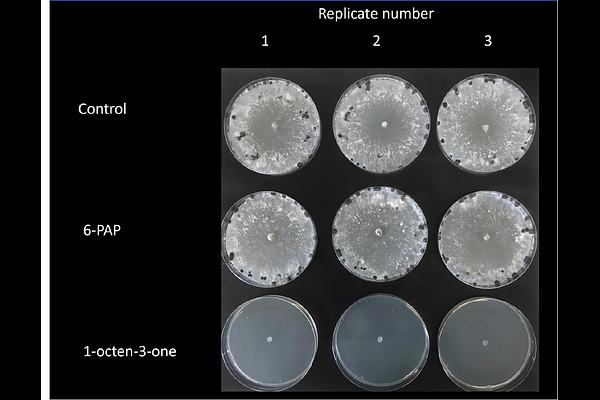Inducible volatile chemical signalling drives antifungal activity of Trichoderma hamatum GD12 during confrontation with the pathogen Sclerotinia sclerotiorum

Inducible volatile chemical signalling drives antifungal activity of Trichoderma hamatum GD12 during confrontation with the pathogen Sclerotinia sclerotiorum
Thomas, G.; Vuts, J.; Withall, D. M.; Caulfield, J. C.; Sidda, J.; Grant, M. R.; Thornton, C. R.; Birkett, M. A.
AbstractBACKGROUND: The use of beneficial soil fungi or their natural products offers a more sustainable alternative to synthetic fungicides for pathogen management in crops. Volatile organic compounds (VOCs) produced by such fungi act as semiochemicals that inhibit pathogens, with VOC production influenced by physical interactions between competing fungi. This study explores the interaction between the beneficial soil fungus Trichoderma hamatum GD12 strain (GD12), previously shown to antagonize crop pathogens such as Sclerotinia sclerotiorum, to test the hypothesis that its antagonistic effect is mediated by volatile chemical signalling. A GD12 mutant deficient in the chitinolytic enzyme N-acetyl-{beta}-glucosaminidase {Delta}Thnag::hph, which shows reduced biocontrol activity, was also examined. RESULTS: In dual-culture confrontation assays, co-inoculation of GD12 and S. sclerotiorum led to fungistatic interactions after 7 days, whereas {Delta}Thnag::hph showed no antagonism, indicating a loss of antagonistic function. VOCs collected from individual and co-cultures were analysed by gas chromatography - flame ionization detector (GC-FID) analysis and coupled GC-mass spectrometry (GC-MS), revealing significant differences in VOC production between treatments, with VOC production notably upregulated in the GD12 + S. sclerotiorum co-culture. Peak production of 6-pentyl-2H-pyran-2-one occurred 17 days post-inoculation. This upregulation was absent in the {Delta}Thnag::hph co-culture, suggesting VOCs may drive antagonism. Synthetic VOC assays revealed several compounds inhibitory to S. sclerotiorum, including 1-octen-3-one, which also arrested the growth of key fungal pathogens (Botrytis cinerea, Pyrenopeziza brassicae, and Gaeumannomyces tritici). Structural insights into 1-octen-3-one\'s antifungal activity against S. sclerotiorum are also presented. CONCLUSIONS: These findings support the hypothesis that the antagonistic properties of T. hamatum GD12 against crop fungal pathogens can, in part, be attributed to VOC production. Further research is needed to assess the potential of these semiochemicals as tools for pathogen management in agriculture.